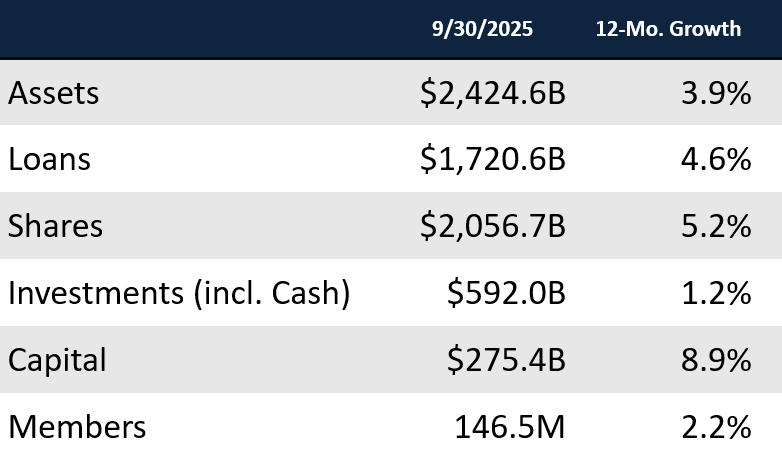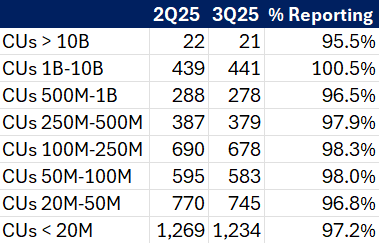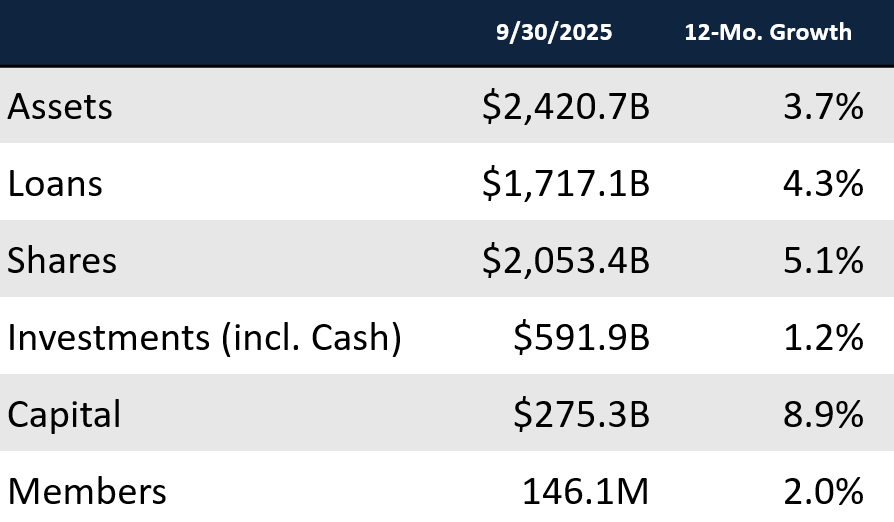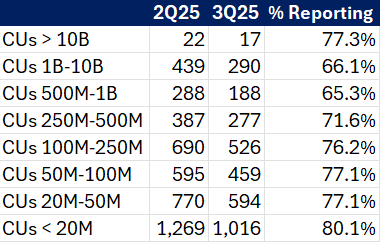It’s reporting season, and Callahan’s FirstLook provides an early look at credit union data. Looking for crucial insight about quarterly performance results weeks before the official data release? Callahan & Associates has you covered. Catch up on the latest trends below or dive deeper into the trends that matter to you with Peer Suite, Callahan’s online performance benchmarking tool. Schedule your demo today.
According to this quarter’s FirstLook performance figures, what’s notable about third quarter performance? And what does it suggest about today’s trends?
11.05.25 Update
- Total loans are set to grow 4.6% year-over-year, fueled by residential other real estate (HELOCs) with growth of 16.2% and commercial real estate with 11.9%. First mortgage balances are on pace to grow 5.1%. This is a faster annual rate than last quarter and could be a sign that rate cuts are reinvigorating the mortgage market.
- Credit card balances are up, 3.6% year-over-year, but overall consumer lending is down. Auto is down 0.6%, driven by a 2.8% decrease in new auto lending. Other, miscellaneous loans — personal, boat, RV, etc. — are also down 0.2% annually. Tariffs likely play a role here as high prices weigh on tight budgets; however, expected cuts to the federal funds rate could drive more growth in the future.
- Share balance growth is tracking at 5.2% year-over-year. This is the highest rate since the third quarter of 2022. Growth in every share type is up annually; however, regular share growth is on track to drop quarter-over-quarter. Money market and certificates — especially certificates with less than 12-month maturity terms — are reporting the fastest annual growth, at 8.6% and 7.1%, respectively. Quarter-over-quarter, the 2.3% growth in certificates leads all other share types. Rate cuts — both past and potential — could be leading savers to lock in higher rates to ensure better returns and near-term liquidity.
- Thus far, the cost of funds is holding steady from last quarter. That could change when loan demand heats up if institutions start to compete for deposits via expensive certificate promotions.


10.31.25 Update
- Analysts at Callahan & Associates put annual asset growth at 3.7%. That’s a slight pick up from 3.6% annual growth one year ago. Loans are on track to grow 4.3%; share growth is set to reach 5.1%, both up from the second quarter.
- Meanwhile, membership is on track to grow 2.0%, consistent with last quarter’s dampened figure but still representing another 3 million members joining the credit union movement.
- Slower growth aligns with credit unions’ strategic decision to pull back from indirect lending, given that indirect members tend to hold just the one loan with a credit union and can pull focus from core members. FirstLook data shows indirect lending is down to 19.9% of total loans.
- The move to refocus on core members appears to be paying off. The average member relationship — as defined by the average loan balance per member plus the average share balance per member — is tracking up slightly from last quarter to $24,329 as of Sept. 30.
- Share draft penetration also is tracking up — 18 basis points from last quarter to 63.1% as of the third quarter. That 63.1% of credit union members hold a draft account is notable because the metric is a common proxy for member engagement.
- Asset quality has continued to deteriorate slightly. Total delinquency is on track to increase 4 basis points quarter-over-quarter; net charge-offs appear to have dropped by 1 basis point compared to midyear. The rise in delinquency is present across every loan type except for commercial loans. Take note: Worsening asset quality allows credit unions to look for opportunities to help members keep their vehicles, make day-to-day purchases with credit cards, stay in their homes, and much more.
- ROA, which is currently at 0.80%, is tracking up 4 basis points from last quarter and 12 basis points from the third quarter of 2024. The net interest margin is up 3 basis points from last quarter to 3.4% as credit unions continue to reprice existing products.
- Net income growth continues to grow at a fast clip, 21.7% year-over-year. Interest income is the driving force here and is up 21 basis points year-over-year as a percent of assets. Interest on loans is set to grow 8.8% since the third quarter of 2024; however, interest income might start to drop sooner rather than later given the recent cuts to the federal funds rate.


 Trendwatch 3Q25. Explore third quarter performance trends and learn about their impact on the industry today with Callahan & Associates. Callahan hosts and industry guest presenters highlight where credit unions are excelling, where challenges are emerging, and how peers are responding. Don’t wait to gain key benchmarks, strategic takeaways, and insights to navigate the rest of 2025. Register to attend today.
Trendwatch 3Q25. Explore third quarter performance trends and learn about their impact on the industry today with Callahan & Associates. Callahan hosts and industry guest presenters highlight where credit unions are excelling, where challenges are emerging, and how peers are responding. Don’t wait to gain key benchmarks, strategic takeaways, and insights to navigate the rest of 2025. Register to attend today.
 CreditUnions.com updates this page with the freshest FirstLook credit union performance data every quarter, so don’t forget to come back for more insights.
CreditUnions.com updates this page with the freshest FirstLook credit union performance data every quarter, so don’t forget to come back for more insights.